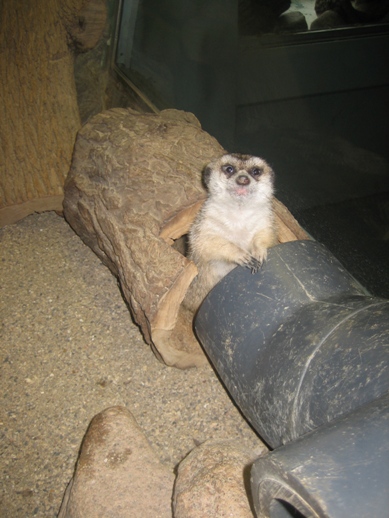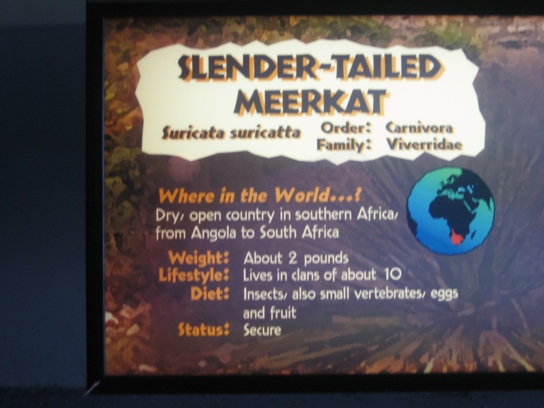Zookeeper Experience (What’s it
like working with Meerkats?)

I don’t know about you but when I was little I always wanted to be a zookeeper. So I decided to go home for a weekend and interview a small mammals’ zookeeper. In the Milwaukee County Zoo the meerkat is located in the small mammals building. The Milwaukee County Zoo had a father, mother, and child meerkat in October of 1999. But today the only survivor is the child. The father died from heart complications while the mother died of brain/neurological problems. Rhonda, the small mammals’ supervisor zoo keeper, told me that the child meerkat had been alone for about a year or so. She told me that meerkats are very easy to take care of. Rhonda also looked up the longevity of the meerkat in which she said they are expected to live around twelve years in captivity. For more information look at the Reproduction page. Her zookeeper also said that since this species thrives on being in groups or mobs. She said that Sashie, the meerkat, is fine but she could do a lot better with a group of meerkats. To read more about this go to the Interactions page. She said that they are looking for a prospective male meerkat to introduce to Sashie, but she stated that introducing new meerkats are hard since normally they want to kill each other if they are not from the same group. If Sashie was bonded with a male meerkat she would easily start a family and breed. By starting off with a male instead of a group, Sashie could get use to this male and start her own family. If a group was brought to the exhibit there would be tension and competition with each member. If they had their own children they would naturally be a group instead of forcing Sashie to be part of a different group.

A certified
enclosure by the wildlife department is
necessary for the meerkats because they
are injurious species.
An injurious species means that
they could potentially hurt those around
them and need to be watched at all
times. A story about
Sashie is that she likes to sit up in a
basket in the exhibit and peer out the
window and watch the keeper make her
food. Rhonda said
that Sashie is a very nosy creature that
needs to know what the zookeepers are
doing at all times of the day.
Everybody in the Small Mammals
building gets fed at 2:30pm, so Sashie
waits and watches with an extreme
attention span to be fed.
Some effects of Sashie being
alone are that she needs more
interaction with other meerkats to give
her something to do so she isn’t bored.
Also, Rhonda declared that Sashie
use to cuddle with her parents before
they went to sleep and Sashie was also
extremely sassy probably as a result of
her being an only child.
Sashie beat up her mother
probably over food or stress levels, but
the zookeeper weren’t exactly sure.
Sashie beat up her mother by
biting her on the check and chewing the
tip of the mother’s tail.
This behavior shows us that
meerkat’s behavior can be overly
aggressive even to meerkats of the same
group. Rhonda also
told me that once blood is in the
exhibit the meerkats’ get even more
excited or riled up.
Could you imagine doing this to your
mother? Well Sashie’s
mom forgave her because she would still
cuddle with her mom at night.
The zookeeper wasn’t quite sure
why this occurred between the mother and
the daughter. Rhonda
is hoping that Sashie gets a mate
because she says they are very easy to
come by and that breeding meerkats aren’t
too difficult. She
says that there are very few problems
breeding in captivity once a male and
female meerkat start mating.
One reason that meerkats come
readily available is because meerkats
get ousted from groups.
This happens because meerkats
have a huge social dynamic and have a
very complicated family life.
So, if you ever go to the
Milwaukee County Zoo in
Two zookeepers take care of all of the animals in the entire building. On regular basis zookeepers medicate animals, feed and make the diets of each animal, observe the animals, clean exhibits every day, rearrange the exhibit, train animals to go in crates and scales so an accurate reading can take place. Observing each and every animal is important because you need to know when they are sick and when they aren’t acting right. She said that animals are very good at hiding their injuries because in the wild the animal would just get killed. Zoo keepers need to know if animals are eating, limping, or acting funny. Another important task of a zookeeper is to enrich each animal because they get bored very quickly. An example for the meerkat is that she would get food in a ball that she would have to figure out how to get the food out to eat. Rhonda said that everyday isn’t the same and new situations come up all the time. In the zoo setting Sashie eats dog food, cat canned food, fruits, veggies, sometimes egg, and a lot of bugs. One thing Rhonda says is interesting about being a supervising zookeeper is because the Small Mammals’ Building is the only building that you can go into all of the exhibits and interact with all of the animals. Other buildings you have to shift animals out before you go in or there is no interaction because the animals could potentially harm the zoo keeper. Another reason that she likes it in the Small Mammals’ Building is because there is a lot of variety in species. Rhonda was a zookeeper since 1999 and has been a supervisor for about three years. I would personally like to thank her for her time to talk with me.


*There has been some controversy regarding what family the meerkat is in previously the meerkat was in the Viverridae family, but now it is in the Herpestidae family. The picture taken on the right was taken at the Milwaukee County Zoo in front of the actual meerkat exhibit.
Amanda Hustad Copyright © 2007, Design by: Sunlight webdesign